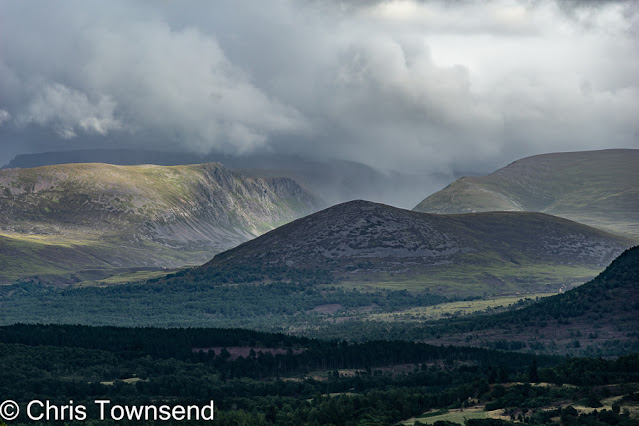 |
| Swirling clouds in the Lairig Ghru |
The forecast of clearing clouds and touches of sunshine for the evening suggested a late walk on the Cairngorm Plateau, especially as winds were forecast to be light so midges were very likely lower down. The heavy rain and the thick clouds blanketing the hills when I arrived in Coire Cas weren’t so encouraging. I checked the forecast for Cairn Gorm again. The sunshine and evaporating clouds had vanished, replaced by rain and drizzle. Wandering round in mist and wetness didn’t appeal – I’ve done that too many times. A change of plan then.
 |
| Creag an Leth-choin during a brief clearance |
Creag an Leth-choin (Lurcher’s Crag), that rugged peak dramatically overhanging the mouth of the Lairig Ghru pass, was just brushed by the clouds. It’s 200 metres lower than the Plateau and so more likely to stay clear. I decided to head that way. I remembered a path up Lurcher’s Gully below the peak, though I hadn’t been that way except when it was snow covered (it’s a great downhill ski run) for many years. This path isn’t shown on the OS 1:50,000 map but is on the 1:25,000. Was it still there? Finding out would be interesting.
 |
| Buachaille Etive Mor & Creagan Gorm |
Exiting the car I was instantly assailed by midges. A man in a t-shirt passed by flapping his arms. “The midges are terrible”. I set off briskly, the rain having given away to gentle drizzle. Across Glenmore the heather was purple on Buachaille Etive Mor and Creagan Gorm, until they disappeared into rain and cloud.
 |
| The line of the path up Lurcher's Gully just visinle |
The start of the Lurcher’s Gully path where it left the main path up to the Plateau wasn’t clear. When I found it the path was narrow and overgrown. In places it was barely visible. I lost it several times soon picked it up again. The walking was no easier on the path than off but trying to find the line was an intriguing game.
 |
| Springs in Lurcher's Gully |
The fading path suggests not many people come this way, which is a shame as the wide gully is lovely and colourful in summer with masses of flowers – mainly heather and bog asphodel, in places bog cotton, tormentil, common butterwort, harebells, and even some hawkweed. Higher up a series of springs and wet flushes glowed bright green, yellow and red. A covey of grouse, maybe a dozen, exploded from the heather noisily.
 |
| Rainbow |
A squall swirled over Glenmore, hiding the hills, then swept on over Cairn Gorm, leaving a bit of rainbow in its wake.
 |
| View over the Lairig Ghru |
The gully gradually ended on flatter ground which I wandered across to the edge of the Lairig Ghru. Across the deep cleft of the pass clouds and rain squalls drifted over Strathspey. Looking back there was a similar scene over Cairn Gorm. Some of the clouds were below me.
 |
| On the summit |
Rocky slopes led to the short summit ridge of Creag an Leth-choin. The clouds thickened and the Lairig Ghru became a seething mass of vapours. All around the summit the swirling mass continued, a very mobile atmosphere. Ring ousels flitted and called in the rocks.
 |
| The Lairig Ghru |
Mist came and went as I rested on the summit. The air was damp and chilly. On the descent the cloud lifted at first, giving a good view along the curves of the Lairig Ghru and out to hazy hills split by shafts of sunlight. Then the mist enveloped me and stayed most of the way down, creating a silent vague world.
 |
| Sunset |
I was almost back at Coire Cas when a line of red appeared under the clouds far to the north-west. The sun was setting. Soon the clouds flared up, startlingly bright and fiery, a stunning finish to the rather atmospheric day.
 |
| Coire Cas Glowsticks |
Not quite the finish though. After the sunset had faded I could see two glowing lurid green columns rising into the air, the raised Coire Cas car park barriers. Why they have to look like giant glowsticks I can’t imagine. I’d rather they didn’t.























